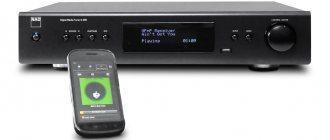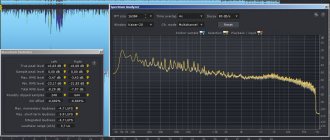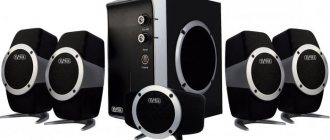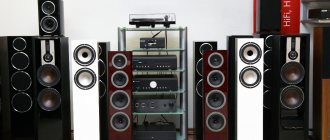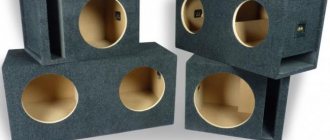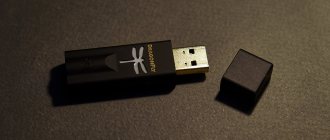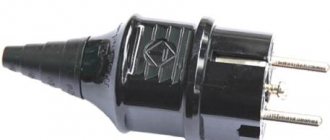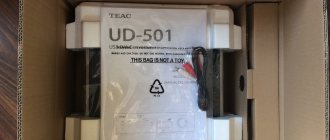Are you ready to throw away your CDs and join the music revolution? These days, more and more people are starting to use streaming services such as Tidal, Spotify and Qobuz, realizing their versatility and convenience. However, to get the most out of these services, it is important to find the right device that will stream your playlist from the above platforms.
The best music players and receivers should support a large selection of high-resolution file formats, as well as offer Wi-Fi and USB connectivity. Of course, users will also want additional features, such as Internet radio, a podcast platform, and so on. After checking out the following selection of the best music audio players, you will definitely find the right option that will meet your requirements, and perhaps surprise you with its modern functionality and stylish design.
Cambridge Audio CXN v2
Wireless connection: Wi-Fi, AirPlay
Connectors: coaxial audio input, optical audio input, USB 2.0 Type A, USB 2.0 Type B, Ethernet 10/100, stereo audio output, coaxial audio output, optical audio output, balanced stereo audio output
This music streamer stands out for its wide range of connectivity options and smooth performance. For under $1,000 you'll get an easy-to-control audio receiver (via the Cambridge Connect companion app), plus a wide range of services you can connect the CXN to, including Tidal, AirPlay, Chromecast and Spotify Connect.
The discreet and elegant design of the case, which is distinguished by high-quality assembly, will fit well into any room. This mid-sized audio component delivers impressive and enjoyable sound quality and a range of features, including support for high-resolution files.
The sound quality provided by the Cambridge Audio CXN v2 is truly excellent. You can clearly hear the dynamic soundstage, down to the smallest detail at the ends of the range.
All functions and settings are controlled via the Cambridge Connect app for Android and iOS. It has a clean, well-designed and intuitive interface that allows users to quickly find exactly what they need. Even beginners should have no problem getting to grips with the Cambridge Audio CXN v2.
The only downside is that, unlike most other players, with the CXN v2 you have to connect a separate USB Wi-Fi adapter to the rear panel. However, this is a fairly simple task, moreover, this operation only needs to be done once. In terms of all-round performance and usability, the Cambridge Audio CXN v2 network player ranks among the top performers in its category.
Sony HAP-Z1ES
Wireless connection: Wi-Fi, AirPlay
Connectors: USB 2.0 Type A, Ethernet 10/100/1000, stereo audio output, balanced stereo audio output
You probably won't be surprised by the fact that Sony has long been the leading music player company. However, with a system capable of delivering high-resolution audio, the Sony HAPZ1ES 1TB marks the company's first step into the streaming space.
The first thing you notice immediately after connecting the Sony stereo system is how well balanced the sound is. The mids and highs are smooth and clear, and the bass is incredibly heavy. The soundstage is solid, with instruments clearly positioned, and it's surprising how detailed the sound is from Sony's use of the DSD audio format. Sony HAPZ1ES conveys literally every element of the composition in its original form. Some might find the campiness and character lacking here, but we think the HAP Z1ES's sonic signature is anything but bland or unemotional.
As you would expect from Sony, the brand's network player stands out with its very sleek and stylish design.
The way you stream music here is noticeably different from its competitors. Most music streamers simply play music from a network server, also known as a NAS. Instead, the Sony HAPZ1ES provides users with a 1 terabyte hard drive, allowing you and me to load up your existing music library and listen to your favorite tracks.
The Sony HAPZ1ES high-definition music player combines the manufacturer's traditions and its innovative approach to any new product.
Marantz PM7000N
Wireless Connectivity: Wi-Fi, Bluetooth, AirPlay 2, HEOS Support
Connectors: coaxial audio input, optical audio input, USB 2.0 Type A, USB 2.0 Type B, RS-232, stereo audio output, coaxial audio output, optical audio output, headphone output
The PM7000N is one of the best music solutions for home audio today, combining the functionality of a Marantz stereo amplifier with the HEOS streaming that has become an integral part of Denon and Marantz network players.
The Marantz PM7000N delivers unconditional sound quality. Inside this streamer there are several components that deliver strong audio performance, including the Asahi Kasei AK4490EQ DAC chip, which is a technical advancement over what was used in the older ND6006 network player model.
The amplifier circuit was also overhauled: in an effort to simplify the signal path and reduce the number of circuit components, Marantz integrated a field-effect transistor (FET) into the input stage of the new integrated phono stage design. The PM7000N provides 24-bit/192kHz PCM streaming via digital inputs (USB, coaxial and two optical) and music servers, as well as 5.6MHz DSD streaming via USB input and streaming platforms. To improve performance, you can use analog mode to turn off all digital sections when not in use. The result is sound that beats many other streaming players, including more expensive models from Primare. The Marantz PM7000N has a wide soundstage and delivers clear, crisp sound.
However, despite the excellent sound, the Marantz PM7000N player still has one drawback - its appearance. Of course, it is not so terrible that it will spoil all the positive impressions of its work, but we can confidently say that we have seen better-looking modules than the PM7000N.
You can buy the Marantz PM7000N network stereo amplifier HERE
Comparative test of network audio players from 15 to 100 thousand rubles.
Playing music using a computer, which was unimaginable 20 years ago, was once expensive. Back then, a hard drive to store recordings from one CD cost about the same amount as a small car. Now, on the contrary, the cost of storing such a volume of data is mere pennies. In such situations, it becomes very interesting to have a voluminous collection of music in a box the size of a book.
If you simply take a laptop and connect it to a Hi-Fi system using a mini-jack cable, it will become obvious that this solution is full of shortcomings, ranging from poor sound quality to the limitations that such a connection imposes on the use of the computer itself.
The solution to the problem is a device that will have a number of computer functions for accessing data on the network or on connected drives and at the same time have a high-quality audio path and a user interface designed to control audio functions. This device is a network player, or, in other words, a streamer. For the first time, our blind jury will listen to six streamers to determine which one has the most hi-fi sound.
Along with playing popular audio formats (lossless, such as WAV or FLAC, as well as compressed, such as MP3), streamers allow you to listen to Internet radio and other streaming broadcasts on the Internet, thereby becoming a very flexible source of entertainment. Some even come equipped with FM and/or DAB tuners, and many also serve as docking stations for portable music players, including the ubiquitous iPods and the like. Of course, no one is saying that streamers and hard drives should replace CD players right now, but they can complement the system in a way that will open you up to music in ways you've never known before.
Cambridge Audio Sonata NP30
(RUB 22,000)
Cambridge Audio's Sonata line is aimed at the budget sector, and the body and external attributes of this player are relatively modest. But the savings haven't affected the internals, so the Sonata offers support for a wide range of formats and sources, and the user interface isn't too different from more expensive streamers. Will audio be the same?
Cyrus Stream X
(98,000 rub.)
Designed primarily for integration into the Cyrus digital system, the Stream X is equipped with a digital output only. It also has multiple digital inputs, making it a potentially powerful system hub. The streaming capabilities of the device are good and it comes with an all-new bi-directional remote control that will encourage the user to completely rethink the previous experience.
Logitech Squeezebox Touch
(RUB 15,000)
A troublemaker in the world of mainstream computer accessories, the Touch may be small and cheap, but it looks very attractive thanks to its large screen and touchscreen. It also offers a full range of inputs and outputs and adds features that no one else has, including disc cover display and even Facebook linking!
Marantz NA7004
(RUB 35,000)
In a well-equipped group of competitors, this network player stands out mainly in its source support, accepting not only FM and DAB radio, but also AM. It controls your iPod, including via AirPlay, and of course works with regular online streaming services, but it can't connect to a network via Wi-Fi. Marantz has an impressive track record in digital audio; will this device benefit from it?
Rotel RDG-1520
(RUB 35,500)
This "Gateway to Digital World" is very close to the Marantz model in terms of capabilities and in this case supports wireless networking (via a dedicated dongle), neatly adding 21st century features and sources to a user interface that will feel pleasantly familiar to anyone who has used at least digital tuner.
Yamaha NP-S2000
(RUB 41,500)
To some extent, the most obvious audiophile streamer in our review - it looks luxurious and has balanced audio outputs. However, at one time this solid device received a lot of reproaches for its functionality, although it supports most network and Internet audio formats. But will its sound justify certain limitations in ease of control?
IMPARTIAL VERDICT
As music collections migrate to hard drives and servers and the number of online radio stations and services grows, the need for quality streaming devices is moving from the category of isolated precedents to an entire trend with its own laws.
Receiving devices face one problem - susceptibility to interference and signal degradation when transmitted through a computer network. In extreme cases, this can result in signal loss, but even less noticeable artifacts can result in distortion and reduced signal-to-noise ratio or dynamic range. In modern devices, however, these transport difficulties are overcome, and we are seeing more and more quality streamers.
In our group test, we evaluated the players' own analog output stage and, if possible, connected a separate DAC to the digital output. This highlighted some potential problems when a manufacturer tries to reduce the cost of power supplies. A reduced and potentially noisy power supply to the amplifier circuit on the analog output can affect dynamic range and distortion, while low voltage in the digital part can cause loss of synchronization from small fluctuations. By observing the output power, we can make a guess as to where the performance is deteriorating - in the device itself or during transmission.
Overall, our group performed better than we expected, overcoming network interference and producing good results on the analog output. So we can explain the dissimilarity in the sound of the participants by the difference in analog output stages and converters, and the overall results turned out to be surprising and interesting in such a wide range of form factors.
High Definition Editor's Note. According to the rules of partnership agreements, we do not have the right to change ratings. exhibited by our British colleagues. Nevertheless, I would like to note that the final rating of the Yamaha NP S200Q was reduced by the author of Hi-Fi Choice precisely taking into account the price of the player, which in the UK is 1,400 pounds. In Russia, the Yamaha NP-S2000 costs half as much, which makes it a very good choice.
OPINION OF “BLIND” LISTENERS
It's always fun to do the first group test in a category, and this was no exception. We had a vague idea of how it would go, but were glad it ended without any hiccups. The test results showed that the technology is already surprisingly mature and ready for people to use in everyday life - as, for example, they buy and immediately turn on CD players.
In terms of sound, we had a hard time noticing some difference between the participants, but in terms of features and ease of use, things are certainly not the same. The Cambridge Audio and Yamaha models had the hardest time. Given that the Cambridge Audio Sonata NP30 is the second cheapest of the group, this might seem a little harsh, but the Logitech Squeezebox Touch is hard to compete with and we didn't feel the Cambridge lived up to its billing. There's something missing in his sound that grabs the listener. The Yamaha NP S2000, of course, sounds better, but it has a rather high price and limited capabilities - let's remember, for example, the lack of USB, which is always good to have; Yes, the sound should have been a little more energetic. The Cyrus Stream X (which costs the same in the UK but requires an external DAC) beats it in most respects.
The Marantz NA7004 and Rotel RDG-1520 are very close in functionality and not too different in price, and we ended up with the same ratings. In the end, we would give a very slight advantage to the Marantz model, but both of these participants are actually so close in almost everything that you have to choose based on personal preferences. The Marantz player handles FM radio better if that's important to you, while the Rotel unit handles wireless networking, which may be a deciding factor for others.
The Rotel RDG-1520 does not support high-resolution files correctly, but most users will not find this to be an issue. Despite the new technology, both devices appear to continue the home audio traditions of their respective companies, which may speed up the selection process if you've encountered these brands in the past.
WINNER!
We didn't have to rack our brains to determine the winner. If a contender in a group test sounds at least as good as the others, has features the others don't, and sells for a rock-bottom price, then what's left to do? And even if you find that the Squeezebox Touch's analog outputs sound a little dull (note that our biggest criticism of it was its slight lack of power), this can always be improved with the help of an external DAC (there is a wide selection of popular models here) and still keep the price around thirty thousand rubles. Plus, you may already have a DAC. And you will get a lot of pleasure from this device. Proper audiophile sound coupled with a cutting-edge look and feel - how could we not love it?
Adapted from HIGH DEFINITION By RICHARD BLACK, HI-FI CHOICE
Bluesound Node 2i
Wireless connection: Wi-Fi, Bluetooth, AirPlay 2
Connectors: optical audio input, USB 2.0 Type A, USB 2.0 Type B, Ethernet 10/100/1000, stereo audio output, coaxial audio output, optical audio output, headphone output
Audiophiles view the Bluesound Node 2i with great suspicion. As a compact music player with a built-in DAC that offers support for hi-res music streaming services, this device seems too cheap—at $549—to live up to that description. Let us remind you that a high-quality digital-to-analog converter alone to complement your system will cost that much, and maybe more.
But take my word for it, the Node 2i is something that really deserves your attention, as it's the best "affordable" quality Wi-Fi player we've seen in recent months. By creating an airy, open soundstage (not cluttered or compressed) with just enough precision and confidence, music practically spills out of this tiny enclosure in the most graceful way.
Of course, Node 2i will be especially responsive and will show its full benefits if you load it with really good music. For example, choose a carefully designed internet radio with a higher data rate that monitors every communication channel. We also recommend spending a few bonus dollars per month to stream 24-bit/96kHz (and sometimes even 192kHz) hi-res content from an account on Qobuz, Tidal, etc.
In addition to these online sources, Bluesound Node 2i is ready to retrieve music from your SSDs, network-attached storage, or anywhere else you might want to organize your personal music library (using a gigabit Ethernet port, Wi-Fi 5, or Bluetooth 5.0 with aptX HD support). The device supports high-definition formats FLAC, ALAC, WAV, AIFF and MQA, as well as MP3, AAC and WMA.
Yamaha WXC-50
Wireless connection: Bluetooth, Wi-Fi, AirPlay, DLNA
Connectors: line input, trigger, subwoofer output, coaxial, optical, USB Type A, Ethernet RJ-45
The Yamaha WXC-50 is a networked streaming preamp with multiple wired inputs (optical, RCA, USB, Ethernet), as well as wireless Bluetooth connectivity, allowing you to access stored music on your phone/tablet, as well as playlists on Spotify, Pandora platforms , Juke, Qobuz and Internet radio stations with the ability to control playback in several rooms at once through the MusicCast application.
There is a separate output for the subwoofer with its own volume control, configurable via the application.
The WXC-50 has a durable metal body with an aluminum lid and a slim, compact design that allows you to place it almost anywhere.
Connect the WXC-50 to any other AV receiver, soundbar or wireless speaker, then download the free MusicCast app to connect the player to your home Wi-Fi network and create a powerful streaming audio system from multiple components across multiple rooms.
In the app, you can quickly select sources, browse your music library, and control playback and adjust the audio equalizer.
The WXC-50 comes with a small remote control with limited functionality. The Yamaha streamer supports high-resolution audio—including FLAC/WAV/AIFF up to 192 kHz/24-bit, Apple Lossless (ALAC) up to 96 kHz/24-bit, and DSD up to 5.6 MHz—for more accurate reproduction of audio details, resulting in natural and atmospheric sound of the entire audio system.
Network Players Review: Voiced Bytes
Today we're pitting award winners ranging from $620 to $2,300 against newcomers in three head-to-head battles. Cabasse and Bluesound will compete in the ultra-lightweight division for the title of best player for beginners. Then good old Cambridge Audio will battle with five-star Pioneer for leadership in the mid-range segment. And finally, in the highest price category there will be another representative of Pioneer, this time the flagship of the line, and one of the famous Cyrus players.
Attention to the ring! The fight begins.
Up to $700 BLUESOUND NODE vs CABASSE STREAM SOURCE
Bluesound Node $700
If anyone thought, like us, that the five-star rating for fledgling company Bluesound's Powernode turntable last September was a fluke, they were wrong. In less than a year, Bluesound's HD music ecosystem has made waves in the streaming space while making a foray into the multi-room market.
The Node is an entry-level component without an amplifier; but although its success is largely determined by its characteristics, the main role is still played by sound quality. Rich and balanced, amazingly detailed and spacious sound will not leave anyone indifferent.
Wyclef Jean's cover of Wish You Were Here delights with the subtlety and texture of its acoustic intro; Each blow of the bow on the strings of the violins is clearly audible. The muffled radio in the background murmurs just right; Cabasse enhances it too much.
The sound cannot be called the most fiery, but it is quite energetic; Node clearly likes this familiar melody – the guitars are pleasingly dense, Jean’s voice is perfectly crafted.
Bluesound's spaciousness and organization allow it to give shape to the lush arrangement of The Smiths' There Is a Light That Never Goes Out. There are many elements to this heavy composition, but unlike what Cabasse provides, the instruments have plenty of room in the layered soundstage. The weighty design of the background sounds creates a solid foundation for electric guitars; the fast pace doesn't confuse Node.
Its inherent clarity, detail and openness are reflected when streaming 320 kbps streams from Spotify. The piano part in Madam by The Unthanks is exceptionally informative; fragile folk vocals are written out in all the finest details.
The convenient and reliable free Bluesound app for iOS and Android is the best way to manage Node. Once the player is connected to the network and to the amplifier, the application instantly detects it; if for some reason this does not happen, you can quickly configure it manually.
The app serves as a portal to music stored on your home network (unlike Cabasse Node, it supports FLAC and WAV formats up to 24-bit/192 kHz) and a gateway to a myriad of streaming services.
Bluesound recently expanded its extensive catalog of services - Spotify, Rdio, Deezer, Quobuz and TuneIn Radio - with new ones including Tidal, WiMP, HDtracks and Slacker Radio. There is a convenient sidebar to access music and services.
The player has many useful connectors, including a USB port for a flash drive or Bluetooth adapter, which can be purchased separately.
However, in pursuit of functionality, Bluesound did not forget about appearance. The cubic design of the Node, in a glossy black or white finish, is compact enough to be picked up with one hand and placed on a shelf. Stylish, modern design and eye-catching accents complement the outstanding sound quality.
Grade: 5
PROS: Rich and sophisticated sound; accurate, spacious, balanced sound stage; tons of streaming services; ease of setup; application
CONS: Nothing
VERDICT: Good in everything - from sound quality and equipment to design and price
Figures and facts
- Optical output:1
- Coax. output:0
- Optical input:0
- Coax. input:0
- USB port:1
- Wireless network: Yes
- Resolution:24bit/192kHz
- Dimensions (H×W×D):15×21×17 cm
- Weight:1kg
Cabasse Stream Source $620
For those planning to dive into the world of streaming, the Cabasse Stream Source is sure to please—and not just because of its fun elliptical shape. The most affordable model in the Cabasse streaming line supports multi-room functions and HD music playback - and pleases with very decent sound.
In tests of other Cabasse models, there were a lot of complaints about the app being buggy and confusing, so we were glad to see a much more convenient option - the new StreamControl app (see sidebar). And if the smartphone is too far away, a small remote control (which looks like a smaller copy of the device itself) allows you to change the input and volume, as well as switch songs.
The amplifier should be connected to the analog or optical output of the Stream Source. In addition to playing files over your home network, Bluetooth with NFC support is available, as well as a rear USB port into which you can insert a flash drive.
In addition to popular formats such as WMA, AAC and MP3, Stream Source supports WAV and FLAC files with sampling up to 24-bit/96 kHz - unfortunately, not up to 192 kHz, like Bluesound.
Cabasse has a very pleasant sound: full and balanced, as well as detailed and organized - both when playing 24-bit/96 kHz WAV and low-resolution streams from Spotify.
Energetic (sometimes even too much) and exciting Cabasse player easily handles the juicy electric guitar riffs, bouncy keyboards and elastic bass of The Cure's Just Like Heaven. Bluesound's drums sound a little more punchy, but the Cabasse's controlled highs come in very handy when the drummer starts hammering the cymbals.
Norah Jones's voice in traditionally calm compositions is presented purely and focused, Cabasse convincingly writes out all the nuances. But richer arrangements, such as Johann Strauss's Voices of Spring, require precise separation of instruments and the space between them, and in this regard Cabasse is inferior to Bluesound.
CABASSE UNDER CONTROL
The new app (StreamControl, free for iOS and Android) is much better than the previous one - Stream Audio Control. A convenient sidebar allows you to access your own music, as well as Spotify and Deezer; Several Cabasse devices can be combined into a multi-room system. The app is easy to use
With minimal reservations, we are quite satisfied with the quality of the new application, so the only obstacle between Stream Source and an excellent rating is the strength of the competitor. Bluesound boasts more dynamic, rich and spacious sound, more streaming services and support for higher resolution HD music. It certainly costs a little more.
But on the Stream Source side there is a pleasant and exciting sound, a lot of useful functions and an affordable price. It's a perfect introduction to the world of music streaming.
Grade: 4
PROS: Enviable enthusiasm; detailed and balanced sound; new convenient application; USB port
CONS: Bluesound has a more dynamic, detailed and spacious sound; no support for 24 bit/192 kHz
VERDICT: A good player at a great price, inferior to Node in sound quality
Figures and facts
- Optical output:1
- Coax. output:0
- Optical input:0
- Coax. input:0
- USB port:1
- Wireless network: Yes
- Resolution:24bit/96kHz
- Dimensions (H×W×D):4×23×13 cm
- Weight:0.5kg
$700–$1400 CAMBRIDGE AUDIO STREAM MAGIC 6 V2 vs PIONEER N-50A
Cambridge Audio Stream Magic 6 V2 $1350
For about double the price of the previous two models, you'll not only get a more traditional look and display, but also a significant improvement in sound quality - if you choose wisely. The Cambridge Audio Stream Magic 6 V2 is the new, newly released version of the 2014 Product of the Year award winner. The upgraded player has more functions and connections, as well as higher sound quality.
Once connected to your home network - wirelessly or directly using an Ethernet cable - Stream Magic 6 V2 is capable of streaming files in all popular formats (MP3, WMA, AAC) and in high resolution (FLAC, WAV and ALAC up to 24 bits). 192 kHz).
Alternative sources such as a computer or USB drive can be used - the built-in DAC is compatible with the same file formats via coaxial input, asynchronous USB Type B, and front and rear USB Type A. Optical input is limited to 24-bit sampling. 96 kHz.
In addition, if you purchase the BT100 receiver for $110, you can stream files from a smartphone or tablet via Bluetooth. Regardless of the source type, Stream Magic 6 V2 automatically upsamples to 24-bit/384 kHz using proprietary technology.
However, Cambridge is not as good at everything as we would like. The text display, with bright blue letters on a black background, is clearly readable only when viewed from the front, but not from an angle. And compared to the Pioneer N-50A's high-contrast LCD display, it feels dated.
But what's most disappointing is the app. Owners of Apple devices can download the full version of Stream Magic, but owners of Android devices will have to make do with Stream Magic Lite - nice, but not without bugs. It is worth noting the high quality of the remote control, conveniently located buttons and a large, responsive round control.
Once installed and configured, many wonderful moments await you: Cambridge is a born entertainer. Its energetic and dynamic character, rich palette and groovy rhythmic drive make the sound informative and exciting.
The piano on Macklemore and Ryan Lewis' song Same Love delights with its subtle dynamics; The voices are exceptionally alive. The duo's richer compositions are just as excellent for Cambridge: colored with lively rhythms, lush synthesizer chords and ringing cymbals, they sound precise and balanced.
Compositions from a USB flash drive highlight the high quality of the DAC: in the recording of Bob Marley's song No Woman, No Cry with 24-bit/96 kHz sampling, high detail and texture of instruments are revealed.
The developers paid a lot of attention to reducing jitter and noise levels. Even low-resolution MP3 playback impresses with clarity and detail. The Cambridge turntable is quite good, but it has some very talented and more affordable competitors.
Grade: 4
PROS: Wealth, balance, elaboration; rhythmic drive; clear and spacious sound field; convincing dynamics
CONS: The display is difficult to read at an angle; unfinished Android application; price
VERDICT: Definitely good, but not as good as a less expensive competitor
Figures and facts
- Optical output:1
- Coax. output:1
- Optical entrance:1
- Coax. entrance:1
- USB port:3
- Wireless network: Yes
- Resolution:24bit/192kHz
- Dimensions (H×W×D):9×43×31 cm
- Weight:4 kg
Pioneer N-50A $725
After checking out the Pioneer N-50A, we immediately knew it was great for the price range. Has the Cambridge Audio player ever met its equal?
We really like the minimalism of the rugged case in black or silver finish. The front panel is made of brushed aluminum and creates a solid appearance that is pleasing to most music lovers; But even nicer is the 3.5-inch LCD display - not only bright and clear, but also displaying a lot of information - from stream parameters to album cover.
It is convenient to control playback using the remote control. The free ControlApp for iOS and Android is well-designed and has a great interface. Both control options are nicer than the Cambridge's. Pioneer is not far behind in terms of format support. Unlike Cambridge Audio, it can stream PCM files up to 32-bit/192kHz and DSD up to 5.6MHz, and play them from a computer connected to an asynchronous USB B port. Hard drives and devices The Apple can also be connected to USB (it supports FLAC and WAV files up to 24-bit/192kHz) or optical or coaxial inputs.
DLNA and AirPlay support ensures compatibility with NAS servers and smartphones. Through AirPlay you can listen to recordings from iPhone and iPad, Spotify and Internet radio will also be useful to many.
If this is not enough for you, then you can look for the AS-BT200 Bluetooth adapter (about $90) and the AS-WL300 module ($90) for wirelessly connecting the N-50A to a network hub.
Pioneer also didn't lose face in terms of sound quality. With punch and outstanding dynamics, it delivers amazingly immersive sound like we've rarely seen from network players under $1,000.
Alexandre Desplat's "Mission" from Pioneer's "The Imitation Game" soundtrack does a great job of conveying the step-by-step increase in volume as it transitions from quiet, tranquil moments to bold instrumental passages.
The tonal balance is impeccable: highs are soft and controlled, lows are elastic and dense. The N-50A isn't afraid to put the pedal to the metal; In Michael Jackson's song PYT (Pretty Young Thing), the rapid attack of powerful rhythms emphasizes the sound of the singer's voice.
Pioneer's built-in DAC is also very good. We like the basic Direct mode best, but you'll want to experiment anyway. The audio restoration feature is designed to optimize playback of low-quality files, but it does result in slightly muffled audio. Overall, this player is great - and costs significantly less than some of its competitors.
Grade: 5
PROS: Dynamic, accurate, detailed sound; many digital inputs; format support; bright and clear display; construction and finishing; price
CONS: No built-in wireless network support
VERDICT: Great sound, wide range of formats, stylish design and great price
Figures and facts
- Optical output:1
- Coax. output:1
- Optical entrance:1
- Coax. entrance:1
- USB port:3
- Wireless Network: No (optional)
- Resolution:24bit/192kHz
- Dimensions (H×W×D):10×43×33 cm
- Weight:7.5 kg
VERDICT
Each model has its own advantages in different parameters; At first it was difficult for us to decide how to choose the best one. The Cambridge has richer bass and a more spacious soundstage, but we still gave the victory to the Pioneer - not only for its excellent sound quality, but also for its convenient application, stylish design, and attractive price
$1400–$2300 CYRUS STREAM Xa vs PIONEER N-70A
Cyrus Stream Xa $2300
In the area of HD music streaming, Cyrus has long been unrivaled. Ever since our magazine highlighted network players as a separate category in 2011, Cyrus has always been on the list of winners - which is not surprising, given the company's decade of experience in developing broadcast solutions.
The Cyrus Stream Xa sits somewhere between the preamp-equipped Stream XP2 and the DAC-less X Signature; One of the newest Cyrus models was featured in the December 2014 issue.
This is an undeniably Cyrus product, not only for its half-width aluminum body and black-and-green display, but also for the character of its sound: precise, agile and controlled, with impeccable musicality suitable for works of any genre.
The exciting and transparent sound of Stream Xa never fails to captivate the listener. This faithful reproduction of Tchaikovsky's First Piano Concerto delights with the precise placement of the instruments and the delicacy and texture of their voices. Thanks to the variability of dynamics, the Cyrus perfectly conveys changes in the character of the orchestra's sound, for example, the richness of the decisive opening and the subtlest variations of the strings.
Almost surgical precision and organization of sound do not conflict with energy and vitality. The light-hearted rhythms of Supertramp's "Breakfast In America" are delivered with a lively and joyful delivery. The piano chords in the unforgettable introduction are exceptionally clear and punctual.
The open and spacious Stream Xa music stage has plenty of room for everyone; the vinaigrette of trombones, brass and piano in the song's chorus is delightfully spacious.
Cyrus has a balanced tonal balance: clear and detailed midrange, ringing, clean and controlled highs, as well as agile melodic bass. The Pioneer N-70A has a richer, warmer and deeper sound, but the neutral Cyrus has a thicker sound.
The vocals are clear and detailed and delight with the multi-layered nature of all elements.
In addition to sound quality, Stream Xa is easy to use - as it should be in this category. It's capable of streaming at up to 24-bit/192kHz over a network via Wi-Fi, although we traditionally prefer a more stable wired connection.
TuneIn Radio gives you access to 100,000 Internet radio stations from around the world; digital inputs (three coaxial, two optical, one USB) and a built-in 24-bit DAC allow you to complement the list of sources with computers, USB flash drives and portable devices.
The small three-line display isn't very useful for browsing through folders, but there are two alternative options: the Cadence app and the n-remote.
CYRUS MANAGEMENT
The logical and user-friendly Cyrus Cadence application has a well-thought-out structure and useful links. For those who prefer physical influences, there is an “n-remote” remote control - a jack of all trades, with a small display for navigation. You can quickly get used to the button layout, and searching for the desired music is surprisingly fast.
The Stream Xa's compact form factor won't appeal to everyone; but its magical sound will conquer everyone. At the end of last year, it showed the best result in its price category and was rightfully awarded. Several months have passed since then; will he retain his leadership? It all depends on its new competitor - the Pioneer N-70A.
Grade: 5
PROS: Precise, agile, organized sound; transparency; expressiveness; LF control; clean, ringing high frequencies; convenient application and “n-remote” remote control
CONS: Not everyone will like the design
VERDICT: Fantastically cool player that sets the standard for sound quality
Figures and facts
- Optical output:0
- Coax. output:1
- Optical entrance:2
- Coax. entrance:3
- USB port:1
- Wireless network: Yes
- Resolution:24bit/192kHz
- Dimensions (H×W×D):7×22×36 cm
- Weight:4.2 kg
Pioneer N-70A $1400
Imagine the Pioneer N-50A, only bigger and (at double the price) better, and you get the N-70A, the new flagship player. It entered a fairly static market segment with the specific goal of taking on mastodons like Cyrus. N-70A is 2 cm taller than its brother, equipped with a 6.3 mm headphone output and amplifier; The device looks very durable. In addition to black, a silver finish is also available.
The N-70A supports transmission and upsampling of LPCM files up to 32-bit/384 kHz, and also reproduces DSD 5.6 MHz over a cable connection. There is also DLNA support, and for another $90 you can purchase a wireless adapter.
In addition to broadcasting from Internet resources - Spotify Connect and vTuner - AirPlay is supported for Apple devices. All playback functions can be controlled using the convenient and responsive free Pioneer ControlApp for Android and iOS or a familiar remote control. Like some of Pioneer's other flagship models, the design elements inside the case are placed in separate sections to isolate circuits and reduce signal interference.
The N-70A is very similar in character to the N-50A: it has a clear and large sound, smooth tonal balance, well-developed dynamics and enviable rhythmic drive. However, the sound has become even more grandiose, convincing, detailed - and exciting.
David Bowie's song Moonage Daydream is performed powerfully, matching the Pioneer's appearance. The rhythms are energetic and dynamic, the guitar melodies are delightful, and control is applied in exactly the right places.
The music scene is extremely coherent and organized; Bowie's voice echoes between the speakers. It lacks a little volume; The Cyrus Stream Xa's more open and airy soundscape gives each instrument more space and is also deeper and more multi-dimensional
However, Pioneer recreates the deep and vibrant voice of Johnny Cash so purely and authentically that it gives you goosebumps.
The sound remains dynamic and convincing when playing music from a computer via an asynchronous USB port. The headphone amplifier is just as talented, making it an equally enjoyable listening experience.
The N-70A is a worthy flagship, but the Cyrus Stream Xa raises the bar beyond the Pioneer with precision, refinement and drive.
If you're willing to spend a serious amount of money on a turntable, you're probably expecting maximum sound quality. The N-70A occupies an intermediate position between the N-50A and Stream Xa, but the most logical and practical option would still be the Cyrus.
Grade: 4
PROS: Power and scale; persuasiveness; detail; equipment; quality of construction; clear and bright display; great app; price
CONS: Strong competitors
VERDICT: Pioneer is very good, but with all due respect – still not Cyrus Stream Xa
Figures and facts
- Optical output:1
- Coax. output:1
- Optical entrance:1
- Coax. entrance:1
- USB port:3
- Wireless Network: No (optional)
- Resolution:32bit/384kHz
- Dimensions (H×W×D):12×43×34 cm
- Weight:11.5 kg
Let's sum it up
WINNER up to $700 Bluesound Node
WINNER $700–$1400 Pioneer N-50A
WINNER $1400–$2300 Cyrus Stream Xa
A high price does not guarantee increased functionality, but the leaders - Bluesound Node, Pioneer N-50A and Cyrus Stream Xa - take their toll on sound quality and convenience
How much you spend on a network player - $620 or $2,300 - depends on the sound quality you want. Regardless of price, most models have similar lists of connections, formats and available features; An "extra" $300 won't necessarily get you another USB port or additional file type. It so happens that the model with the best sound has the least equipment in this test.
Ease of use is generally high (especially with the app); There are few things more frustrating than not having the song you want when you need it.
The first couple of participants prove that decent sound can be obtained for a fairly modest price. Fun-looking Cabasse and Bluesound are easy to use and play well; both of them are great for first acquaintance. Increased refinement and dynamism ultimately tipped the balance in Bluesound's favor.
While Bluesound managed to maintain its status, Cambridge Audio was less fortunate; it was beaten by new rivals from Pioneer and lost a star in testing. Despite the slightly higher openness and dynamics of the Cambridge, the Pioneer offers more powerful sound for a lower price. And its flawless interface leaves Cambridge far behind. Considering the price of $725, the Pioneer is perhaps the real star of today's test.
However, sometimes you want to replace timid attempts with decisive action. In this market segment, such a step would be the transition to Cyrus Stream Xa. Here Pioneer was not so successful. Her flagship was called upon to give a decisive battle to Cyrus, but the attack floundered. They both do their job decently, but the sound quality differs by a star. The Cyrus's more dynamic and spacious sound continues to be the standard at this price point and beyond, right up to its sibling, the $4,880 Stream XP2-Qx.
But although only three models were recognized as the best investment options, all participants in the test are very good and can become a worthy addition to your system.
Chord DSX1000
Wireless connection: Wi-Fi
Connectors: coaxial audio input, Ethernet 10/100, stereo audio output, PreAmp output, headphone output, balanced stereo audio output
This is the first online ]Chord[/anchor] player. Essentially, the manufacturer has combined its top-of-the-line Chord QBD76 HDSD DAC with the StreamUnlimited Stream700 module. The result is a top-notch audio streaming tool that supports playback of FLAC or WAV files up to 24bit/192kHz via a wired connection - Ethernet port (24bit/96kHz via wireless connection), offers Internet radio and remote control via an app for smartphone.
Key features include the built-in analog volume circuitry used in the CPA8000 Reference preamplifier, which provides fine volume control without the low-level distortion associated with conventional digital volume controls, a full-color 3.5-inch TFT panel display showing album art, settings, etc. ., as well as analog outputs with adjustable volume and line outputs, which have both balanced XLR and RCA phono connectors. The streamer can be controlled using many companion UPnP applications and media servers available for iPhone, iPad and Android devices.
The DSX1000 can play MP3, WMA, WAV, AAC, ALAC and FLAC, and in the future the streamer will decode SACD. If you're looking for a capable network player that lets you listen to your personal library of audio files, the DSX1000 will ensure your tracks sound great. It's an impressive first step into the audiophile streamer market that developer Chord has made with its new hi-fi device.
TOP 5 – network audio players
The implementation of the beautiful concept of transferring a music library from optical discs to network storage is often hampered by the lack of a playback device that matches the class of the rest of the music system. Of course, you can limit yourself to a personal computer slightly modified specifically for this task or use a network multimedia player as such a source, but such a component will be dissonant as part of a serious High-End system.
Let us recall just some of the advantages that the network concept of storing audio recordings provides. First of all, it became possible to go beyond the sound quality requirements of the Red book - in other words, listen to recordings in resolutions exceeding 16 bits / 44.1 kHz. Of course, in your collection of optical discs it is likely that there will be positions in the SACD format or even the bygone DVD-Audio, which made it possible to get acquainted with high resolution before, but today such recordings are increasingly distributed in the form of multimedia files in high-resolution formats DSD, WAV, FLAC, ALAC and the like. Examples of resources that distribute such recordings include HDtracks , HighResAudio , HD Classic . In addition, network technologies have provided hitherto unattainable ease of navigation through large collections of recordings and control of playback. Modern software solutions allow you to create perfect order in your collection - each album will take its place in the virtual storage and will never get lost in the mass of other publications. In addition, it becomes possible to combine your favorite songs into playlists that can be compiled and remembered for various situations. And finally, the size of the music library is now in no way limited by your living conditions and is determined only by the amount of memory allocated for its storage. If we are talking about a home server, then the cost of a terabyte of disk space is now quite affordable, and, unlike high-resolution video, storing music recordings even in the highest quality requires relatively modest amounts of disk memory. For example, even for high-resolution music with 24-bit / 192 kHz parameters, approximately 12,000 tracks or about 1,200 music albums will fit on a 2 TB disk. As a bonus, networking technologies in audio offer additional capabilities. For example, listening to Internet radio stations. Broadcasts on the Internet erase any boundaries, which is physically impossible with broadcasting. Again, there is no limit to the number of available stations, since there is no longer any need to compete for the broadcast frequency range. As a result, on the World Wide Web you can find stations specializing in almost any kind of music.
All that remains is to teach your music system to work with content posted on the Internet. a regular computer can handle the task of playing music from the network . We, of course, will not seriously consider the option of using it autonomously to listen to music through multimedia speakers or laptop speakers, but by equipping your computer with a high-quality external DAC with a USB interface , which, in turn, will be connected to your stereo system, you can achieve very good results. But the best option, both from the point of view of ease of use and from the point of view of sound quality, would be to use a specialized network streamer, that is, an audio file player capable of receiving music material in one way or another from storage on a home or global network. In addition, such a source can combine a player and storage, and in this case we get a more or less autonomous device, which concentrates both the music library itself and the functionality for playing audio files. True, it still won’t be possible to do without integrating such a component into a computer network, since the control of the music library and playback is organized through an application for a smartphone or tablet that communicates with the music source over the network. The functional content of such audio sources also differs - often the digital part and the DAC are combined in one case, but there are implementations of pure digital “transport”, which imply the use of a separate external DAC unit.
In this review, we have tried to present the range of offerings available on the market in this area without attempting to rank the participants. And does such a rating make sense when the cost of components differs by more than twenty times?
The prices shown are indicative, as of the beginning of April 2016.
Price – 713,990 rub.
The Astell&Kern brand is strongly associated with high-end portable audio players. Having earned the recognition of audiophiles in this market sector, the company decided to expand into the field of stationary components, introducing a network media player with an integrated preamplifier and headphone amplifier Astell&Kern AK500N. The design of the first stationary model from Astell&Kern resembles the appearance of its mobile counterparts. The aluminum façade is designed with an asymmetrical cut, and the cubic shape of the body breaks the stereotypes of component hi-fi. On the front panel of the device, only the slot for the CD drive is visible, part of the switching arsenal and the drum volume control are removed to the right side of the case, and the main control, a seven-inch touch screen, is located on top. In general, the continuity of the ergonomics of portable solutions is clearly visible, which is a workable option for a stationary device, although not the most convenient when used as part of a component system.
An almost complete set of possible digital inputs and outputs is implemented here - optical, coaxial RCA, BNC and balanced AES/EBU. The USB port is available in two versions - type A Host (for connecting external drives) and type B Device (for connecting to a computer as an external audio interface). You can integrate the device into your home computer network either wired using the RJ45 Ethernet port or “over the air” using the built-in Wi-Fi adapter. You can also stream music from mobile gadgets directly via Bluetooth. Analog outputs are implemented in both asymmetrical and balanced versions. Moreover, both options are duplicated - one is designed for direct connection to a power amplifier when the pre-amplifier built into the Astell&Kern AK500N is working, and the second is linear, and can be used to integrate the component into an existing audio system as one of the sources. Outputs for connecting headphones with a diameter of 6.3 mm, 3.5 mm and balanced, as well as an additional USB port for external drives and a slot for a microSD card are located on the right side of the case for convenient quick access. The power supply here is external. The component is equipped with a battery for complete isolation from mains interference. At the same time, the battery life of the device is 7 hours. One 1TB SSD is standard installed inside and there are three expansion slots for connecting additional drives. Thus, the Astell&Kern AK500N disk memory can be expanded up to 4TB.
In addition to playing files from DLNA servers on the network, as well as receiving broadcasts via Airplay or Bluetooth from mobile gadgets, the Astell&Kern AK500N is capable of digitizing CDs into its internal storage, as well as acting as a server for storing the entire music collection, providing easy and quick access to music library from network devices and portable gadgets. We also note a very high-quality built-in headphone amplifier, which ensures operation even with balanced models. To control the component, you don’t even need a smartphone or tablet as a remote control - its own high-resolution screen fully meets the tasks of managing the network complex. A convenient menu system facilitates filling and systematization of the music library; when placing the Astell&Kern AK500N on the desktop, everything is fine. Another option, when the device is crowned with a standard rack for audio equipment, makes you dream about a decent remote control.
Considering the considerable price of the product and the reputation of Astell&Kern, expectations in terms of sound quality were the highest - the design features and the most modern element base of the AK500N guaranteed its success. Listening only confirmed that this is a worthy competitor to such pillars of digital audio as components from Linn and Naim, an almost flawless source of the new generation. Moreover, in terms of the quality of work with headphones, this is one of the best devices that have ever been in our laboratory. If “silent” sessions are the main or significant part of the gadget’s job responsibilities, then, perhaps, this is the best solution for your money today. As a component of the most serious high-end audio packages, it will also not lose face and will provide a completely new level of detail and fidelity compared to classic digital sources.
Pros:
excellent sound, high-quality headphone amplifier, rich set of functions
Minuses:
ergonomics as a component of a block system are not ideal
Passport details:
Type – Network audio streamer with preamp and headphone amplifier | Name – Astell&Kern AK500N | Frequency response, Hz – 20 – 20,000 (±0.02 dB) | Playback – DSD64, DSD128, WAV, FLAC, WMA, MP3, OGG, APE (Normal, High, Fast), AAC, ALAC, AIFF, DFF, DSF | Sampling frequency, kHz – 8 – 384 | Coding, bit – 24; 16; 8 | Signal-to-noise ratio, dB – 118 | Nonlinear distortion coefficient, % – 0.0008 | Data exchange – Ethernet RJ45, Wi-Fi 802.11 b/g/n, USB type A, USB type B, Bluetooth | Audio Inputs – AES/EBU, BNC, Digital Coaxial, Digital Optical | Audio Outputs – AES/EBU, BNC, Digital Coaxial, Digital Optical, XLR Stereo Pair (2), RCA Stereo Pair (2) | Additionally – volume control, DLNA, battery, 7-inch touch display, internal storage 1/2/4 TB, CD drive | Dimensions, cm – 21.4 x 24.3 x 23.8 | Weight, kg – 11.4
Price – 220,000 rubles.
Linn's clear product hierarchy places the Majik series on the third step of the pedestal, after Klimax and Akurate. Thus, Majik components are considered budget equipment... by Linn standards, of course. True, the elitist status of the company is determined by the level of quality of even “affordable” product lines, and by prices that cannot be called affordable. Let's just say that Majik components seem to be the most optimal from the point of view of a set of criteria that determine sound quality, functionality and cost. The player does not have an information display, and all settings are proposed to be done over the network, using any available Internet browser. The procedure is not at all complicated: just contact the device’s IP address and the settings menu will open, where you can set all the necessary parameters. Playback control is also remote and is carried out from a regular computer, handheld or smartphone. At the same time, the classic structure of the DLNA system is implemented, in which Linn MAJIK DS acts as a renderer, and a smartphone or tablet acts as a controller. In order to turn a mobile device into a management console, you only need to install a proprietary application on it.
The functionality of the streamer is quite limited. Linn MAJIK DS can receive music content only over the network, and the component can only be integrated into it via a wired method using the RJ-45 Ethernet port. There is no built-in Wi-Fi adapter, no USB ports for connecting external drives or a computer. The component also does not have digital inputs, so it cannot be used as an external DAC. For connection to an audio system, there is an analog pair on RCA connectors, as well as coaxial and optical digital outputs. There is no balanced switching here either.
But the Linn MAJIK DS performs its main function – playing music from network storage devices – brilliantly. The sound quality of the player more than compensates for some limited functionality. The device demonstrated a collected, dense, very balanced sound with precise detail and impressive dynamics. Linn MAJIK DS is capable of giving a lot of fun, simultaneously taking streaming beyond the confines of universal computers, which is very important for many music lovers who value the ease of using audio files, but cannot stand everything computer-based.
Pros:
excellent audio path, impressive sound
Minuses:
does not support DSD format and work with external USB drives, no built-in Wi-Fi adapter
